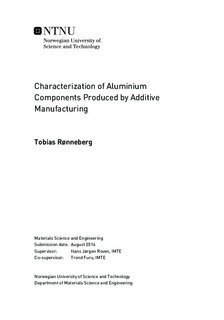Characterization of Aluminium Components Produced by Additive Manufacturing
Master thesis
Permanent lenke
http://hdl.handle.net/11250/2418013Utgivelsesdato
2016Metadata
Vis full innførselSamlinger
Sammendrag
Additive manufacturing (AM) is a new method of manufacturing that can produce physical objects directly from CAD-models. Powder Bed Fusion (PBF) technology can produce metallic parts by selectively fusing powders layer by layer. The metallurgy and properties of such materials are still unknown, but they are clearly unlike equivalent parts produced by traditional manufacturing methods. Two aluminium alloys are investigated in this thesis; an Al-10\%Si casting alloy and a 6061 wrought alloy. Both materials were received as powders and used to build a component in PBF process. Both powders and produced materials were characterized by microscopy and the mechanical properties of the materials were investigated.
The results show that the powders do not consitute an explosion hazard. Apropriate specimen preparaion can resolve the microstructure of the materials, which are various porosity. The porosity is characterized and quantified. Epitaxial microsturctures are found in both materials arising from solidification during production. That result has been observed before for the AlSi alloy, but not for the 6061 alloy. Due to the much lower alloying level of 6061, the structure is likely caused by the solidification conditions rather than the chemical composition. The 6061 alloy is mechanically far weaker than the AlSi alloy in compression and tension. This is partly attributed the large amount of cracks found in the alloy.
